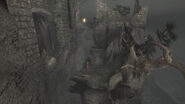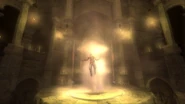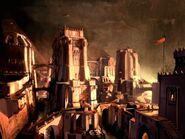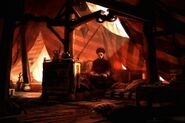
Prince of Persia: Warrior Within
| Prince of Persia: Warrior Within | |
|---|---|

| |
| Data | |
| Developer | Ubisoft Montreal |
| Publisher | Ubisoft |
| Platforms | PC, PS2, Xbox, GC, Mobile, iPad, iPod Touch, PS3, iPhone; Revelations - PSP |
| Released | December 2, 2004 |
| Series | Sands of Time Trilogy |
| Previous game | The Forgotten Sands |
| Next game | The Two Thrones |
Prince of Persia: Warrior Within is a action-adventure and platforming video game sequel to the critically acclaimed Prince of Persia: The Sands of Time. Chronologically, it is the direct sequel to The Forgotten Sands. Released for Xbox, PlayStation 2, GameCube and Microsoft Windows on December 2, 2004, Warrior Within was developed by Ubisoft Montreal and published by Ubisoft.
Warrior Within adds several new features to the base of its previous installment, the Sands of Time. Specifically, the options in combat are expanded, with the lack of the Dagger of Time, dual weapon wielding becomes a far more important part of battles thanks to the ability to steal enemies' weapons. Warrior Within has far darker tone than its predecessor with higher amounts of blood, sexuality and swearing and received a "Mature" rating from the ESRB due to the adult oriented content.
The game found greater sales success, though lower critical acclaim than its predecessor. As a result, a third game was produced and relate the following year. A port of Warrior Within, Prince of Persia: Revelations, was developed Pipeworks and released on December 6, 2005 for Sony's PlayStation Portable. The port includes additional content including three new areas not available in the original release. On November 19, 2010 and April 19th, 2011, Warrior Within was included in the "Prince of Persia Trilogy" alongside The Two Thrones and 'The Sands of Time in a HD Collection for the PlayStation 3 and PlayStation Network.
Gameplay
Much like the original Sands of Time game but with a few major differences. The Prince can wield two weapons and throw his secondary weapon, and pick up another one. He also has the ability to perform several combos and charge attacks. In addition, the Prince can use the environment to his advantage, such as by bouncing off of walls to attack enemies. The new gameplay system was dubbed the "Free-Form Fighting System".The change in timelines also affects the environment in which the player traverses. The present is the ruined and half-destroyed Island of Time and the past is the beautiful and flourishing Island of Time.The player can shift between these two periods through a column of Sand of Time, called a Sand Portal.
Story
The Island of Time
Seven years after the Prince's adventure in India, the Prince seeks counsel from an old wise man. The Prince learns of the existence of the Island of Time rumored to be in the Persian gulf, but is nearly impossible to find. Thinking only of his survival, the Prince sets sail for the Island to prevent the Sands of Time from ever being created, under the belief that the Dahaka will have no reason to hunt him if he does so.His vessel is destroyed by Shahdee and her army. Lost in the shipwreck, and he finds himself alone on the island. He picks a wooden stick from the wreckage of a boat to defend himself against some crows. He swears to kill Shahdee for what she has done to him and his crew.
The player follows a tutorial, and with some minor fights, reaches the bottom of the stairs leading to the Fortress of Time.
Shahdee tries to kill the Prince, but the Prince repels her by knocking her to the ground. After a fight with several opponents he obtains the Spider Sword and begins chasing Shahdee through the Island until they reach a Time Portal. She goes through a Time Portal, and the Prince follows her into the Past.
Continuing his pursuit for Shahdee, he finds her trying to murder a woman in red. The Prince engages Shahdee once more in battle and kills her. The woman introduces herself as Kaileena, a servant of the Empress of Time. Denied an audience with the Empress of Time to state his case, the Prince is then faced with the task of activating two towers, that will will open the doors to the empress' throne room. Kaileena aids the Prince by presenting to him the Serpent Sword, which will activate the bridges to reach both towers. He eventually obtains the Lion Sword, an even more powerful weapon than the previous.
As the Prince explores the island, he occasionally encounters a mysterious, dark-looking creature known as the Sand Wraith. Shortly before reaching the throne room, the Prince is attacked by the Dahaka (which, until this point, had only been encountered in the present) and almost killed, but the dark creature rushes in and is killed in his place. The Dahaka then leaves without attacking the Prince, much to his surprise.
The Prince eventually succeeds in reaching the Throne Room only to discover that Kaileena is the Empress of Time. She had sent Shahdee to kill the Prince, and on the perilous journey to the towers, and even cursed the Lion Sword. Yet, the Prince did not die. Kaileena has seen her fate, which is to die at the hands of the Prince. Accepting this, her only concern is to get rid of him at any cost. Shahdee, feeling that her mission to help save Kaileena was foolish, turned against her only to be killed by the Prince.
The Prince reluctantly fights and kills Kaileena. Returning to the present, he hopes that he has escaped his fate, but soon discovers that when he killed Kaileena, the Sands of Time were created from her ashes. Realizing that he has caused the event he intended to prevent, the Prince begins to lose hope, but soon discovers the Mask of the Wraith, which is said to have the power to defy fate.
When he puts on the mask, he transforms into the Sand Wraith, the dark creature he previously came across in his journey. In this state, the Prince is able to coexist in a single time with his past self, explaining his past encounters with the Sand Wraith. When he reaches the point at which the Wraith saved the Prince from the Dahaka, he instead lets the Dahaka kill his previous self, causing the mask to fall off and him to return to the position he was in just before he entered the Throne Room. The Prince decides that he may not be able to avoid killing Kaileena, but if he kills her in the present rather than the past, the Sands will not be created until after he had used them, thereby escaping his fate. The Prince confronts Kaileena again and forces her through a time portal into the present.
At this point the ending forks, depending on whether or not the player has found all of the health upgrades and acquired the ultimate weapon in the game, the Water Sword. The ending where the Prince wields the Water Sword is the canonical ending as it extensively affects the story of The Two Thrones. The ending where he does not have the Water Sword is non-canon.
Water Sword (Canon Ending)
The Dahaka appears and heads for Kaileena. However, the Prince discovers that the Dahaka has a weakness to his Water Sword. The Prince fights the Dahaka and manages to defeat it. Having both escaped their fates, the Prince and Kaileena set sail for Babylon together. In the ending scene of the boat heading off towards Babylon, the Prince ends up sleeping with Kaileena and beginning a sexual relationship together. While in Kaileena's embrace The Prince sees a vision of Babylon under attack. In the end, the a hooded figure picks up Sharaman's crown saying and declares all that the Prince posses is rightfully his as well.Without the Water Sword (Non-Canon Ending)
- "Your journey will not end well. You cannot change your fate. No man can."
- —Old Man
Characters
- Prince - Hunted by the Dahaka, the Prince is desperate to save himself from his fated death.
- Kaileena - The Empress of Time and creator of the Sands of Time, she plots to destroy the Prince before he can kill her.
- Shahdee - The Empress' servant, she tries to kill the Prince before he can reach the shuttle.
- Dahaka - The guardian of the timeline, the Dahaka seeks to kill the Prince to restore the order of the timeline.
Reception

- "I'm not a fan of the artistic direction, or the violence that earned it an M rating. The story, character, dialog, voice acting, and visual style were not to my taste"
- —Jordan Mechner[2]
Ubisoft contests that these most changes were meant to reflect the Prince's starkly different personality, due to the Prince having to bear the weight of the Dahaka chasing him. This had a negative effect on him, and made him "dark" and "cynical".
Factors of criticism toward the Changes
The following is a list of common arguments against the Warrior Within and its changes compared to the The Sands of Time:- The player can collect items within the game in order to unlock artwork and other extras.
- The story reduces the amount of character development and interaction from The Sands of Time.
- The Prince, who was charming and cheerful yet unsure of himself and his abilities in The Sands of Time, has become an anti-hero branded with tattoos; he cares only for himself and is overly violent and aggressive. When attacked by Shahdee, the Prince call her a "Bitch". As the Sand Wraith, when the Dahaka chases the Wraith out of the library, the Prince hopes for the deity's death and calls him a "Bastard". He will also taunt his enemies in combat ("Is that the best you have to offer?").
- Increased levels of blood and gore. In The Sands of Time, the player fights Sand Creatures who, as creature made of the sands themselves, are devoid of human fluids, and thus unable to "bleed". In Warrior Within the Sand Creatures much bleed when they are struck or cut in half.
- The Persian-influenced music from The Sands of Time is replaced by a Hard Rock soundtrack, though the score still composed by Stuart Chatwood. The game's main musical leitmotif is Godsmack's "I Stand Alone"; Straight Out Of Line"
is used in the credits. The new, dark approach to the game's music was
not appreciated by fans who were disappointed with the change.
- When the Prince is not engaged in any fights, or solving a puzzle, the player can hear some orchestrated music that reflects the environment. When the Prince engages in a fight with multiple enemies, the music changes to a hard rock track. Every time a boss, such as the Empress or the Griffin, is fought, the music is more traditional than hard rock.
- The over-sexualization of characters Kaileena and Shahdee. Where The Sands of Time featured suggestive themes and mild sexuality between Farah and the Prince in The Sands of Time, Warrior Within contained an explicit scene of sexual content between the Prince and Kaileena. Kaileena and Shahdee are presented in the game where in the upper and lower half of their bodies are exploited or empathized during their interactions with the Prince. During the final boss battle with Shahdee, the warrior will taunt the Prince with by slapping her bottom repeatedly until her life bar is severely depleted. Kaileena and Shahdee's outfits are also considered to be sexually exploitative of the female body.
Glitches and bugs
- Players have encountered a glitch dubbed the "Wraith glitch", wherein the player is turned into the Sand Wraith character too early, usually in the chapter "Fate's Dark Hand". The skin appears similar to that of a corpse.
- The same glitch will also occasionally happen in reverse, crashing in a similar fashion before reverting the Sand Wraith to the Prince. In both cases, the player must start over, unless they have an earlier save file.
- There is a "Ghost" glitch during the Prince's first encounter with the Crow Master. After the Crow Master's health is sufficiently depleted, the Crow Master becomes 'spiritless' but yet remains standing and attacking the Prince. The Prince can still deal it damage but cannot kill it, and he can walk though it like a ghost. This usually occurs when players attack the spiritless body of the Crow Master.
- A glitch in the Mechanical Tower can sometimes be found, where the bridge the Prince must raise to gain access to the lever that activates the tower will not rise properly or at all. This can almost always be avoided by doing the Mechanical Tower first.
- A cut scene in the "Southern Passage" does not occur. This cut scene opens a hole in a wall. If the cut scene does not occur, the hole does not appear and the player must revert to a previously saved game.
- While attempting to gain what is usually accepted as the last life upgrade (Southern Passage – Past) after reverting from the Sand Wraith, if the Prince chooses to proceed through the Sacrificial Altar instead of backtracking to the Throne Room the way he came, his only path leads him to Southern Passage – Present. However, the hole in the wall which the Dahaka made there earlier is impassable (even if visible), and the Prince finds himself stuck. This is generally called the "Dahaka Hole" glitch.
- In "The Empress" there is also a glitch which happens when the Empress of Time breaks the wall and the player is skipped to "The Face of Time".
- In the Xbox, GameCube and Windows version of the game, the sound in cut scenes (voice acting, music and sound effects) will sometimes either not be synchronized with the action, or not be present at all.
- At the end of the game: in the time portal room before the final combat, the sand portal sometimes fails to activate when the Prince is in it. Even with an earlier save file, the game must be started over. This "sand portal" glitch is caused by going back through a sand portal that you have already used, so if you want to avoid this glitch don't go through a sand portal more than once.
- A glitch when fighting Kaileena for a second time can be encountered under the right circumstances; if the Prince slows down time, then Kaileena slows down time, then the Prince rewinds time, then he will become four times faster than the game would normally allow, even faster than what fast forward time would allow. This glitch ruins the cutscenes in the battle, however, randomly facing and placing both the Prince and Kaileena.
- During the first encounter with a golem, at the beginning of the Machine Tower, the golem is sometimes invisible making it very hard (but not impossible) to defeat it.
- A glitch when fighting Griffon makes it invisible making it very hard to kill. But since you can see its eyes you can predict where it is.
- When performing a wall run , if the player rewinds time,the prince will sometimes make an infinite wall run until pressing the drop button.
- A similar glitch sometimes occurs in which traps sometimes become invisible making it hard to traverse
- The GameCube version seems to suffer fewer of these glitches, as stated by Gamespot:
- "Some technical flaws in the Xbox and PlayStation 2 versions of the game also mar the experience somewhat. The Xbox version is prone to audio glitches. Certain sound effects get stuck, and, at other times, scenes that should have voice in them are cut off completely. This is a shame, because the sound effects in the game, aside from some ham-handed voice acting from the prince, are excellent and impactful. Meanwhile, the PlayStation 2 version's flaws are graphical. As a result, the game has a slightly choppier frame rate than the other versions. While it's not enough to hinder gameplay or combat, it does detract a bit from an otherwise beautiful-looking game. We didn't notice any sound or frame rate issues with the GameCube version of Warrior Within, however.""
- —Bob Colayco




















No comments:
Post a Comment